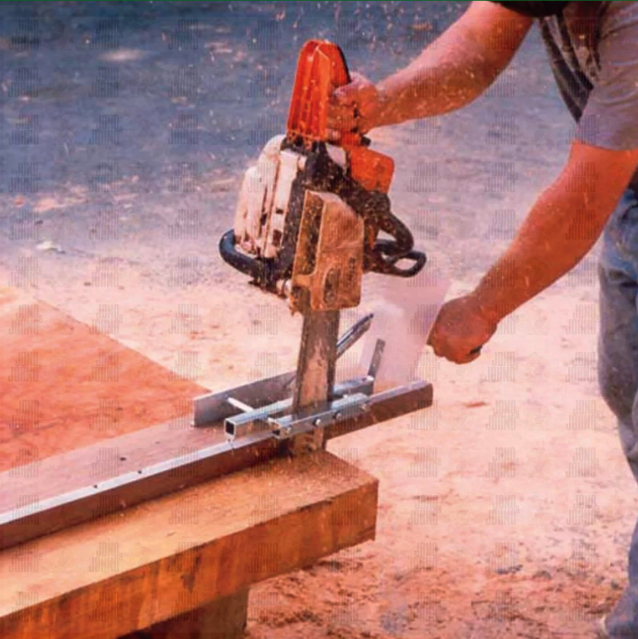
A chainsaw is a powerful tool that can cause serious injuries if not used and maintained properly. Even a small issue, like the chainsaw sputtering at the wrong moment, can lead to an inaccurate cut or even a dangerous situation. A branch might break unexpectedly, or the chain could get stuck inside the tree, making it difficult to control.
For optimal performance, your chainsaw should cut straight and smoothly. If it starts cutting crooked or off-center, there may be several underlying issues. A chainsaw sharpener might be needed, or you may need to replace the cutting teeth entirely.
Here’s what to do if your chainsaw is not cutting straight anymore.
Why Your Chainsaw Cuts Crooked
There are many reasons why a chainsaw might start cutting unevenly. It could be due to a dull chain, misaligned top plates, or damaged cutting teeth. The problem could also come from incorrect chain tension or a worn-out bar.
Uneven Chain Sharpness or Dull Chain
The chain is the part of the chainsaw that actually cuts through wood. If it's not sharpened evenly or becomes dull, it will not cut straight. This is why regular maintenance and proper sharpening are essential for safe and effective use.
Using a high-quality chain, like a Stihl chainsaw chain, can help reduce the frequency of sharpening and improve overall performance.
Incorrect Chain Tension
If the chain is too tight, it can cause unnecessary stress on the engine and potentially damage the chain. On the other hand, a loose chain can derail, which is both unsafe and inefficient. Ensuring the correct tension is crucial for smooth operation.
Uneven Top Plates
The top plate of the chain is the part that makes contact with the wood. If these are uneven, the chain will not cut straight. Regular checks and adjustments can help maintain even cutting performance.
Worn-Out Chainsaw Bar
A worn-out or damaged bar can significantly affect the performance of your chainsaw. It's the part that supports the chain and guides it during cutting. If the bar is damaged, it's time to replace it to ensure safe and accurate cuts.
Damaged Cutting Teeth
Even if you know how to sharpen a chainsaw, some teeth may be damaged from hitting rocks, dirt, or other hard objects. These damaged teeth can cause the chain to cut unevenly, so it's important to inspect them regularly and replace as needed.
Improper Depth Gauge
The depth gauge controls how deep the chain cuts into the wood. If it's set incorrectly, the saw won't cut consistently. Adjusting the depth gauge ensures a smooth and even cut every time.
How to Sharpen a Chainsaw Chain Like a Pro
If your chainsaw isn’t cutting straight, it might be time to sharpen the chain. Here are the steps to do it properly and safely.
Step 1: Clean the Chain
Before sharpening, make sure the chain is clean and free of debris. Any dirt or oil can interfere with the sharpening process and increase the risk of injury.
Soak the chain in a mixture of water and ammonia to remove grease and grime. Then rinse it thoroughly and dry it before proceeding.
Step 2: Adjust Chain Tension
Proper chain tension is crucial for safe and efficient cutting. The chain should be slightly loose on the guide bar but not so loose that it derails.
Adjust the tension using the tensioning screw located on the side of the chainsaw.
Step 3: Start with the Shortest Cutter
Begin by sharpening the shortest cutter first. This helps ensure all teeth are of equal length, which is essential for a straight cut.
Mark the first tooth you sharpen to keep track of your progress.
Step 4: File at the Correct Angle
Hold the file at the angle that was originally ground on the tooth. Consistency is key to maintaining even cutting performance.
Slide the file across the tooth while twisting it gently. Repeat this five to six times for each tooth.
Step 5: Sharpen the Opposite Side
After sharpening one side, flip the chainsaw and repeat the process on the opposite side. Make sure the flat tops of the teeth are roughly the same length after sharpening.
Step 6: Check the Depth Gauges
Finally, check the depth gauges to ensure they are shorter than the adjacent cutters. If they are too long, they will prevent the chain from cutting properly.
Use a file to lower the raker by about 1/10 of an inch below the cutter if necessary.
Find High-Quality Chainsaw Sharpeners at Jono & Johno
A chainsaw that doesn’t cut straight is a safety hazard. Using a quality chainsaw sharpener can help restore its performance and keep it running smoothly. Don’t forget to maintain other parts of your equipment for long-term reliability.
Jono & Johno offers everything you need for your chainsaw, including power tools, replacement chains, and safety gear. Explore our inventory online and reach out with any questions you may have.
Spare Part Of Fracturing Pump,Concrete Pump Spare Parts,Pump Spare Parts,Spare Part Main Pump
Jiangyin Yida Machinery Manufacturing Co.,Ltd. , https://www.yidamachinery.com